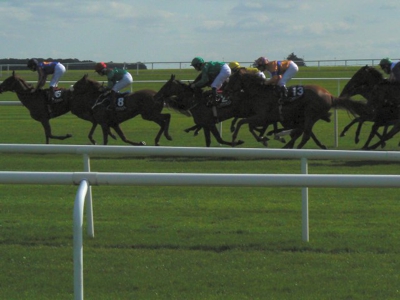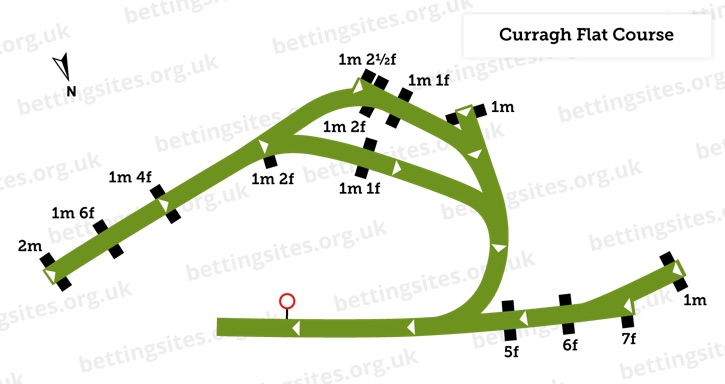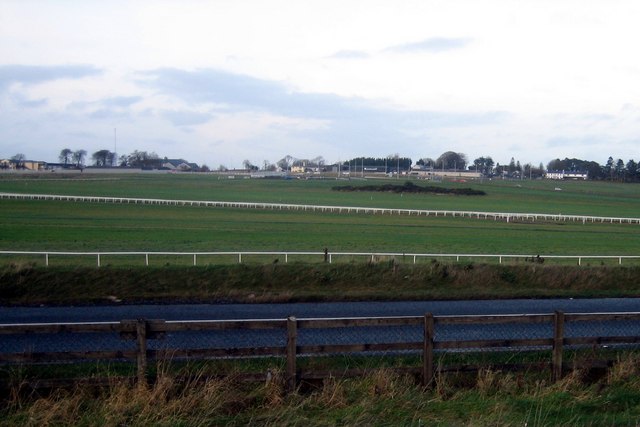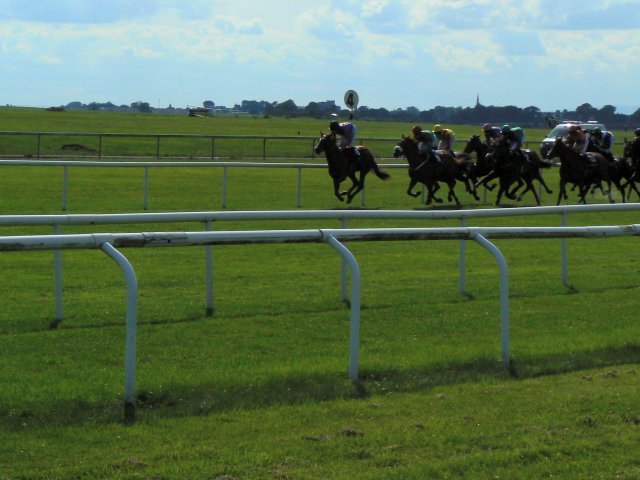Curragh Racecourse Guide

The Curragh, as it is often referred to, is not just Ireland’s best racecourse but also one of the best in Europe. The County Kildare based venue gets its name from the Irish word, Cuirreach, which means "place of the running horse”.
It’s considered the home of Irish flat racing and for good reason, as it hosts all five of the Irish Classic races. By holding such a vast array of quality races, it is little surprise that the Curragh has become a thriving hotspot for breeders and training facilities.
Jump to: Course | Races | Useful Info | History
Map
The Course

The horseshoe track at the Curragh is far from your standard track as it contains several different branches used for different races. The Plate course is the furthest away from the stands with the Derby Course on the inside, accommodating races up to two miles. There is an additional chute closer to the finish posting that can host races a mile long but mile long contests (and shorter) can also feature on the straight track which begins on a slight rise.
The draw bias at the Curragh depends on what course you ae looking at. For the straight track during sprint races, a higher draw, closer to the stand side, is normally favoured as it tends to be a little drier. For any of the other tracks however, being on the inside is preferred as there is a fair amount of turning to be done, including a rather sharp one on the approach to the run in. Overall it has to be considered a fair test, regardless of which course runners are on and one that is also very easy on the eye.
Major Races
The Curragh hosts 10 of Ireland’s 12 Group 1 flat races and it’s fair to say that all of these have to be considered major affairs. Some are bigger than others however, such as the five that form the Irish Classic races. The first two come on the same weekend in May, the Irish 1,000 and 2,000 Guineas. The pair of one mile races enjoyed their inaugural races in 1922 and 1921 respectively.
The day of the Irish Derby, which falls in late June/early July tends to attract the biggest crowds. It’s the oldest of the five Classics and both the sporting and social highlight of the summer season. A prize fund well over €1m also makes it Ireland’s most lucrative race. The next Classic on the schedule is the Irish Oaks that runs in July. Winners are often seen at the following month’s Yorkshire Oaks and there are those that manage the double, for example Blue Bunting in 2011.
The final mention goes to the recently created Irish Champions Weekend, a two day event which begins at Leopardstown but has the final day at Curragh. The Sunday sees high quality races such as the Vincent O’Brien National Stakes, The Moyglare Stud Stakes and the pick of the bunch, the Irish St. Leger. The St. Leger differs from the English equivalent though, as both geldings and horses over three year old are allowed to compete.
Visiting

For those of you interested in some Irish flat racing, the Curragh is the absolute place to be and it usually hosts around 18 racedays from May to September.
Useful Info
Dress Code
There are no formal rules on what to wear at the Curragh but smart dress is encouraged and smart casual is the norm on most days. Ladies are free to dress up in glamorous fashion but there is a greater incentive to do so on the designated ladies’ days throughout the season which usually fall on the biggest meets.
Ticket Prices
For most meetings, adult admission to the Curragh is €15 with senior citizens and the under 25s receiving entry for a discounted €8. Prices increase on days of any of the Irish Classics, however, with entry costing €20 for adults and €10 for senior citizens and under 25s.
The only exception to this is the day of the Irish Derby, where admission for all ranges between €25 and €30. Punter’s Packages, which include €5 to spend on food & drink, a racecard and a betting voucher, can be bought for €20 on non-Classic racedays, €25 on Classic racedays and €30 on Derby Day when pre-booked.
Membership
Adults pay €175 for Membership at Curragh with over 65s and under 30s receiving the lower rate of €100. As well as admission to all racedays, members get a free racecard for each day, over 50 reciprocal meets, reserved parking, exclusive member trips and various special offers throughout the year.
Membership for the three Kildare courses (Naas, Punchestown & Curragh) is also available with prices at €300 for adults and €200 for under 30s and seniors.
Getting There
If relying on public transport then buses and trains can be used to get to the Curragh. Dublin Coaches run on all racedays and collect from the likes of Dublin Airport, Dublin City Centre, Naas, Newbridge and Limerick.
Direct trains to nearby Kildare station run from all over the country and a complimentary shuttle bus service will take you the three miles from the station to the racecourse.
Parking
Unusually, certainly as compared to the UK, there is plenty of free parking on all racedays.
History

The green grass that covers County Kildare has a long history with horses, dating back many centuries. It had been a place for kings in the past and by the time of the 17th century, nobility and gentry would regularly ride their horses in Curragh whether it be for hawking, hunting or racing. With the location a popular one for riding, it was only natural that a racecourse should be built there and the first recorded race took place in 1727 as noted in Cherney’s Racing Calendar.
It didn’t take too long before the Curragh became Ireland’s answer to Newmarket but it’s status was only guaranteed in 1868 courtesy of the Curragh of Kildare Act. The act preserved the right of the Curragh for the purpose of horse racing and settled the rights of common pasture.
Irish Derby
Two years prior to this and spectators witnessed the first appearance of the Irish Derby, with the four other Classics following in the next 56 years. In this time, Curragh saw a huge increase in the amount of stables and stud farms which became a big part of the local economy. Today, Curragh is home of approximately 26% of all horses trained in Ireland.
Redevelopment
With attendances continuing to grow in the decades that followed, talks about huge new redevelopment were discussed and in 2015, the plans were revealed. The ambitious project will see the introduction of a new grandstand, parade ring, weigh-room as well as significant refurbishments to the existing stable yard. The projected cost is a huge €65 million, jointly funded by HRI (Horse Racing Ireland) and private investment. The Curragh is already a great place to enjoy top racing and once this redevelopment is completed things will only get better.

